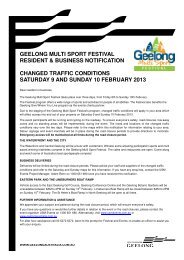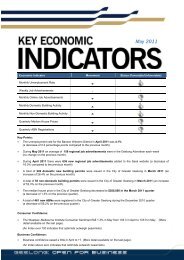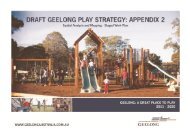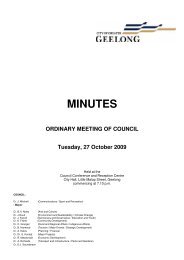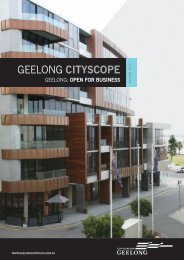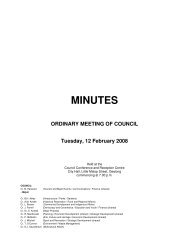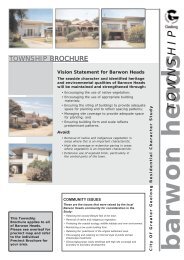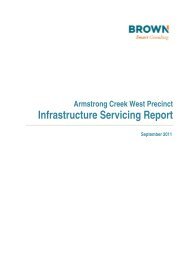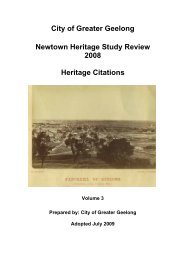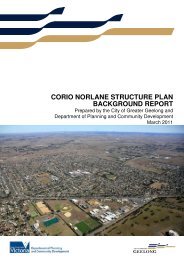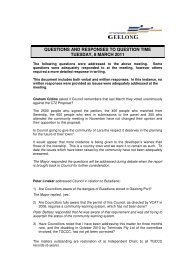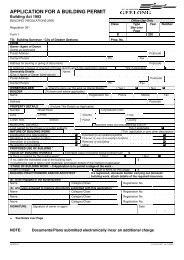armstrong creek urban growth plan volume 1 - City of Greater Geelong
armstrong creek urban growth plan volume 1 - City of Greater Geelong
armstrong creek urban growth plan volume 1 - City of Greater Geelong
Create successful ePaper yourself
Turn your PDF publications into a flip-book with our unique Google optimized e-Paper software.
Dual reticulation systems (also known as 3 rd pipe systems) are another potential<br />
measure to partially replace potable water by providing a supply <strong>of</strong> recycled water.<br />
Such systems are useful for industrial use, watering sports grounds, other public<br />
open spaces and potentially for use in residential gardens, clothes washing and<br />
toilet flushing. State Government policy, as stated in ‘Our Water Our Future’, is to<br />
work with local government, water authorities and developers to support dual pipe<br />
systems for recycling where they are likely to be economically viable.<br />
Currently, Barwon Water’s view is that this may not be an appropriate option for<br />
Armstrong Creek, due to the high level <strong>of</strong> salt in the recycled water produced at the<br />
Black Rock water reclamation <strong>plan</strong>t. The cost <strong>of</strong> desalinating this water to levels<br />
suitable for residential use and then reticulating it to the <strong>growth</strong> area would result in<br />
the cost <strong>of</strong> water being significantly higher than the current cost <strong>of</strong> providing<br />
potable water. A requirement <strong>of</strong> the Essential Services Commission is that Barwon<br />
Water must fully recover the costs <strong>of</strong> all non-essential services such as water<br />
recycling. Therefore, the additional costs associated with the treatment and<br />
reticulation <strong>of</strong> recycled water would need to be covered by either the developers <strong>of</strong><br />
the <strong>growth</strong> area or the broader Barwon Water customer base through increased<br />
water rates.<br />
Council is keen to explore the potential for dual reticulation systems further.<br />
Therefore, it is recommended that this be the subject <strong>of</strong> further discussions.<br />
Another form <strong>of</strong> water recycling that could be developed in the longer term is the<br />
treatment <strong>of</strong> recycled water to potable water quality. After treatment to a very high<br />
standard, recycled water would be stored in underground aquifers before being<br />
pumped back into the potable water storage upstream <strong>of</strong> the water treatment<br />
process to augment traditional water supplies. Distribution would be through the<br />
existing potable water reticulation systems, negating the need for a dual system.<br />
Such systems have already been taken up in Europe, USA and parts <strong>of</strong> Asia but<br />
are yet to be approved for use in Australia.<br />
Electricity (Transmission)<br />
There are two organisations that own, operate and maintain the two electricity<br />
transmission lines within the study area: SP AusNet and Alcoa.<br />
The first line, the <strong>Geelong</strong> – Point Henry line, is owned by SP AusNet. The line<br />
enters the study area at the railway crossing at Marshall and runs in an easterly<br />
direction through to the Barwon River crossing within an easement generally 62.0<br />
metres in width. Within the study area, this easement contains existing double<br />
circuit 220kV transmission line mounted on steel lattice towers (pylons). On the<br />
ARMSTRONG CREEK URBAN GROWTH PLAN / VOLUME 1 (ADOPTED 13 MAY 2008, AMENDED MAY 2010)<br />
114



